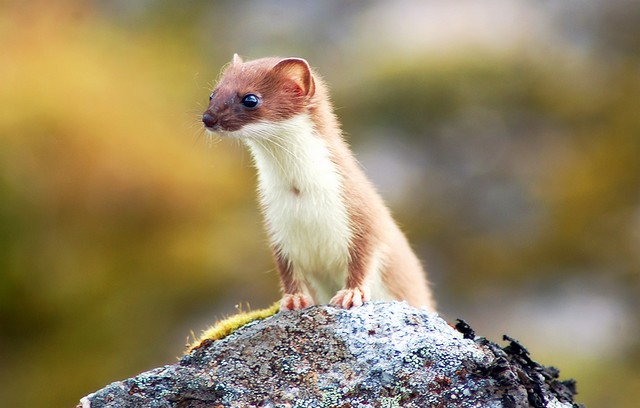Least weasel
A species of Weasel, Also known as Common weasel Scientific name : Mustela nivalis Genus : Weasel
Least weasel, A species of Weasel
Also known as:
Common weasel
Scientific name: Mustela nivalis
Genus: Weasel
Content
Description General Info
 Photo By Cecil Sanders , used under CC-BY-2.0 /Cropped and compressed from original
Photo By Cecil Sanders , used under CC-BY-2.0 /Cropped and compressed from original Description
The least weasel has a thin, greatly elongated and extremely flexible body with a small, yet elongated, blunt-muzzled head which is no thicker than the neck. The eyes are small in relation to their head size and are bulging and dark colored. The legs and tail are relatively short, the latter constituting less than half the body length. The feet have sharp, dark-coloured claws, and the soles are heavily haired. The skull, especially that of the small rixosa group, has an infantile appearance when compared with that of other members of the genus Mustela (in particular, the stoat and kolonok). This is expressed in the relatively large size of the cranium and shortened facial region. The skull is, overall, similar to that of the stoat, but smaller, though the skulls of large male weasels tend to overlap in size with those of small female stoats. There are usually four pairs of nipples but these are only visible in females. The baculum is short, 16 to 20 mm (0.6 to 0.8 in), with a thick, straight shaft. Fat is deposited along the spine, kidneys, gut mesentries and around the limbs. The least weasel has muscular anal glands under the tail, which measure 7 by 5 mm (0.3 by 0.2 in), and contain sulphurous volatiles, including thietanes and dithiacyclopentanes. The smell and chemical composition of these chemicals are distinct from those of the stoat. The least weasel moves by jumping, the distance between the tracks of the fore and hind limbs being 18 to 35 cm (7 to 14 in). Dimensions vary geographically, to an extent rarely found among other mammals. Least weasels of the vulgaris group, for example, may outweigh the smaller races by almost four times. In some large subspecies, the male may be 1.5 times longer than the female. Variations in tail length are also variable, constituting from 13–30% of the length of the body. Average body length in males is 130 to 260 mm (5 to 10 in), while females average 114 to 204 mm (4.5 to 8.0 in). The tail measures 12 to 87 mm (0.5 to 3.4 in) in males and 17 to 60 mm (0.7 to 2.4 in) in females. Males weigh 36 to 250 g (1.3 to 8.8 oz), while females weigh 29 to 117 g (1.0 to 4.1 oz). The winter fur is dense, but short and closely fitting. In northern subspecies, the fur is soft and silky, but coarse in southern forms. The summer fur is very short, sparser and rougher. The upper parts in the summer fur are dark, but vary geographically from dark-tawny or dark-chocolate to light pale tawny or sandy. The lower parts, including the lower jaw and inner sides of the legs, are white. There is often a brown spot at the corner of the mouth. The dividing line between the dark upper and light lower parts is usually straight but sometimes forms an irregular line. The tail is brown, and sometimes the tip is a little darker but it is never black. In the northern part of its range and at high altitudes, the least weasel changes colour in the winter, the coat becoming pure white and exhibiting a few black hairs in rare circumstances. 
General Info
Lifespan
3-6 years
Diet
Least weasel's primary food encompasses small mammals, especially voles and mice. Additionally, it consumes birds, eggs, amphibians, and insects. Its diverse diet adjusts based on local availability and seasonal fluctuations.
Appearance
The small, compact body of least weasel reaches a length of about 24-28 cm, with a short tail. Its long slender form and short limbs are covered by a dense coat that turns white in winter and brownish in the warmer months. Its distinguishing attributes include broad, round ears, and a pointed snout. The underparts are typically paler than the rest of the body. There is no significant difference in appearance between genders or different age groups.
Behavior
Least weasel, also known as the least weasel, is primarily nocturnal with hunting and foraging behaviors adapted for small rodents. It displays solitary behavior, often aggressive when defending its territory, marked by scent from anal glands. Remarkably, this species demonstrates induced ovulation, mating year-round.
Population
Stable